|
By Colonel Harold (Hal) Austin, USAF (Ret.) Page 1 of 3 pages |
||||||||||||||||
| The hot subject on both sides of the Iron Curtain in 1954 was Intelligence gathering. The political/military situation for the time period around May 8, 1954 was that the Cold War was in full swing and the Korean War was nearing the stalemate that has lasted for all of these 40 years. We were quite concerned about the possibility of the Soviets attacking Europe and even the United States with aircraft overflying Canada. Russia was equally as concerned about an attack by the United States.
Some of you will remember that by the 1954-55 time period we had two Strategic Reconnaissance Wings at Lockbourne AFB, Ohio, where my crew was stationed, with ninety RB-47E aircraft plus twenty KC-97 tankers. Also, there were two RB-36 Reconnaissance wings, one at Ellsworth AFB, SD and one at Fairchild AFB, WA. These were the aircraft expected to do the “Open Skies” project which President Eisenhower attempted to negotiate with the Soviet Union. It would have been very interesting trying to cover the entire Soviet Union with those 150 or so aircraft! In 1955 President Eisenhower made a careful evaluation of US policy on disarmament. He invited the other four major powers of the world to join in an agreement for the reduction of armaments and on July 21, 1955, at the Geneva Summit Conference, made his “Open Skies” proposal to ensure peace in the world through the use of aerial reconnaissance. Editor' Note: Received the following info from Paul Hunter, March 6, 2005: “There were two tanker units: The 26Th AREFS and the 91st, each with 20 97s. The 26th moved to Westover and they were replaced by the 376th SRW tanker unit but I don't recall the ARS designator. |
||||||||||||||||
| During 1951-53, my unit, the 91st Strategic Recon Wing (SRW), routinely had about eight RB-45C’s and a similar number of KB-29P tankers deployed on temporary duty to England. In late 1953, we transitioned to the new RB-47E for the same job. During these years our “official” job was to do uncontrolled photo mapping work for the US Army over Europe, primarily the Rhine River basin and later all of Spain, so our maps could be geodetically tied into Eastern Europe. This was a very important requirement because ballistic missiles were soon to be deployed to the NATO area. |
||||||||||||||||
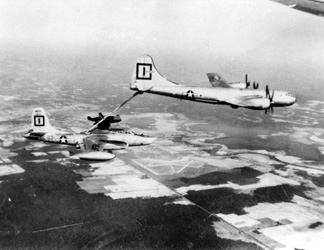 |
||||||||||||||||
|
|
||||||||||||||||
| Our real mission with RB-45C’s, we found out later, was to occasionally furnish them to the RAF. (As a matter of interest, a flight of RB-45C’s, with RAF crews had been over Moscow the night of April 29, 1954, just a few days earlier than our day photographic mission.) |
||||||||||||||||
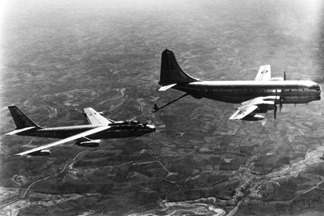 |
||||||||||||||||
| Electronic Intelligence (ELINT) RB-29’s, RB-50’s and later RB-47 aircraft, were also doing periphery work around the Soviet Union, primarily to keep the Soviet Radar Order of Battle up to date. I believe our overflight on May 8, 1954 was the first with the RB-47E visual photo aircraft. |
||||||||||||||||
|
|
||||||||||||||||
| On this particular TDY, my crew, Carl Holt, Co-pilot, and Vance Heavilin, Navigator, and myself, had been in England about two weeks, when on May 6 we launched a “feint” of seven RB-47’s toward the USSR’s “Northern Exposure.” Taking pictures of Spitsbergen Islands, Northwest of Norway, we were well above 75 degrees north latitude. Although we didn’t know it at the time, this “feint” was to set up our mission of the 8th of May. On the 8th of May, the three RB-47E crews for the mission were briefed separately and apart by two SAC Intel Colonels. Our particular mission was to penetrate Soviet airspace and take pictures of nine Soviet airfields to find out for General LeMay if the “new Migs” (MIG-17’s) were deployed to the area. We were also looking for deployed Bison Bombers. The other two aircraft were to proceed with us to a point about 100 miles north of Murmansk and then return to base. |
||||||||||||||||
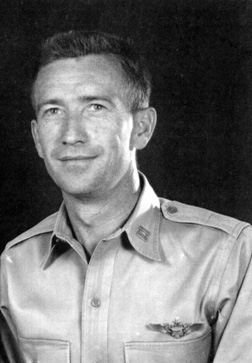 |
||||||||||||||||
|
Vance died in January 1998, in Scottsdale, AZ |
||||||||||||||||
| Our flight of three RB-47s departed RAF Fairford about 7 AM, refueling with our KC-97’s off Norway as we had done two days earlier, flying one mile separation using station-keeping technique (very loose formation) to a point about 100 miles north of Murmansk. The other two aircraft reversed course, as briefed at that point to return to the UK. Our first Soviet airfield targets were two large airfields near Murmansk. We coasted in at 12 noon at nearly 40,000 feet over Murmansk and the Nav turned on his radar cameras and started the three K-17 large area visual photo cameras. The weather was clear as a bell across the entire Western part of the continent, perfect for our K-17 and K-38 cameras. |
||||||||||||||||
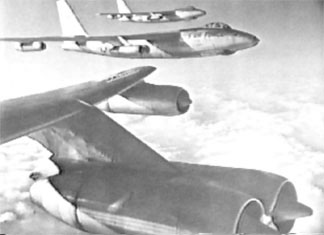 |
||||||||||||||||
|
|
||||||||||||||||
| About the time we finished photos of the second airfield, we were joined by a flight of 3 Soviet Migs. I still don’t know whether or not they were armed, but they stayed a couple hundred yards to half a mile off our wing, making visual identification, I guess. About 25 minutes later, a flight of six Migs showed up. I guess this flight confirmed we were the bad guys, because a few minutes later another two flights of three, a total of six Migs, arrived behind us, with obvious intent to try to shoot us down. |
||||||||||||||||
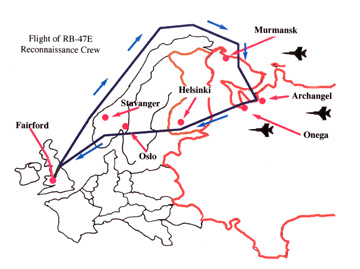 |
||||||||||||||||
|
Home - Contact Us - Cold War Hist. - 91st SRS Hist. - Stardust 40 Mission Story |
||||||||||||||||